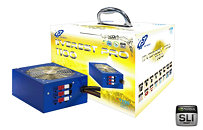Monday, October 20th 2008
FSP Readying New Kilowatt PSUs
FSP is the brand of power supplies that is popular for using Fortron-made components. The company plans to release three Everest Pro models in November, all of which are kilowatt offerings for high-end PCs and workstations. All three models are essentially the same, except for their load capacities: there's a 1250W model, followed by 1200W and 1100W models.
The PSUs are modular. They come with blue-coloured shells, that measure 165 (L) x 150 (W) x 86 (H) mm. The PSUs are cooled by 135mm fans with LED lighting. They are ATX 12V V2.2 and EPS 12V V2.92 compliant, and sport six +12V rails of 20A each. The PSUs flaunt an 80 Plus efficiency-rating sticker, with FSP declaring the efficiency to be over 90%. The PSUs are NVIDIA SLI and ATI Crossfire ready. The power supplies feature an Active PFC, over-current, over-voltage and spike protection. Pricing is yet to be known.
Source:
TechConnect Magazine
The PSUs are modular. They come with blue-coloured shells, that measure 165 (L) x 150 (W) x 86 (H) mm. The PSUs are cooled by 135mm fans with LED lighting. They are ATX 12V V2.2 and EPS 12V V2.92 compliant, and sport six +12V rails of 20A each. The PSUs flaunt an 80 Plus efficiency-rating sticker, with FSP declaring the efficiency to be over 90%. The PSUs are NVIDIA SLI and ATI Crossfire ready. The power supplies feature an Active PFC, over-current, over-voltage and spike protection. Pricing is yet to be known.



18 Comments on FSP Readying New Kilowatt PSUs
FSP power supplies have always treated me well. These look like nice power supplies, I wish I had a use for all that power though, and I'm sure they will be insanely priced.
As for the "90% efficiency" claim - even if it were true, it wouldn't happen before say 500W load, and you'll have to live with mediocre efficiency at the lower digits, where even high-end PC reside when idle. Bottom line, those 1250W beasts seem pretty useless to me (and they are clearly consumer models... server PSU with LED fan, come on...). Thanks god, nVidia and ATI still haven't invented the uber-GPU that would make any sense of them.
If I were to buy such a beefy PSU it would be something like this: www.pcpower.com/power-supply/turbo-cool-1200.htmlYou will find OCZ PSUs (who also own PCP&C now) are single rail.
Up to 30% losses? Really. Please at least use a little common sense instead of just believing anything you read. I'll explain, we'll use these power supplies as examples to get the numbers, but the idea applies to all PSU's.
At 20A per 12v rail is 240w right? Now with 6 rails that makes how many watts total? 1440w... So if we combine all those rails into one 120A rail, you get a single rail that is 1440w, the PSU is only rated for 1200w. Take into consideration the other voltages in the power supply, you are looking about 100w out of that 1200 gone to those. You then have about 1100w left to drive a 1440w rail. I'm not going to go through the math, because I am lazy, but I'm pretty sure that is almost 25% loss right there regardless of rail configuration.
So sorry to break it to you, but PCP&C is wrong. Even with a large single rail, 100% of the 12v output can't be transfered to the computer, and there isn't a component on the market today that draws 240w from a single rail. And the few graphics cards that come close to that 240w power draw, draw it from at lest two seperate rails, most actually 3.
The reason for multi rail power supplies, are pretty much what panchoman said, and the reason that if you read some real good reviews of OCZ and PCP&C power supplies, you will see a lot of complaints of voltage drops under load.
Neither design is better than the other. Pros and Cons exist for both.
Here's a better explanation from Jonny Guru.
www.jonnyguru.com/forums/showthread.php?t=3990@newtekie - A TEC can draw 240W off of a single rail, and yes, some people are crazy enough to run them off of their main psu. lol
The quote you gave basically agreed with the line PCP&C gave, nether claimed its better but rather the 20A limit per line isn't there, hardcore overclockers can easily pull more than 20A off one 12v rail.
I just don't feel comfortable with having a large single 12v rail with the PSU is rated for more then 40A, but as already said it is really just personal preference. Maybe it is my small background in electrical work which tells me an 18AWG wire isn't meant to hold up under much more than 20A at 12v.